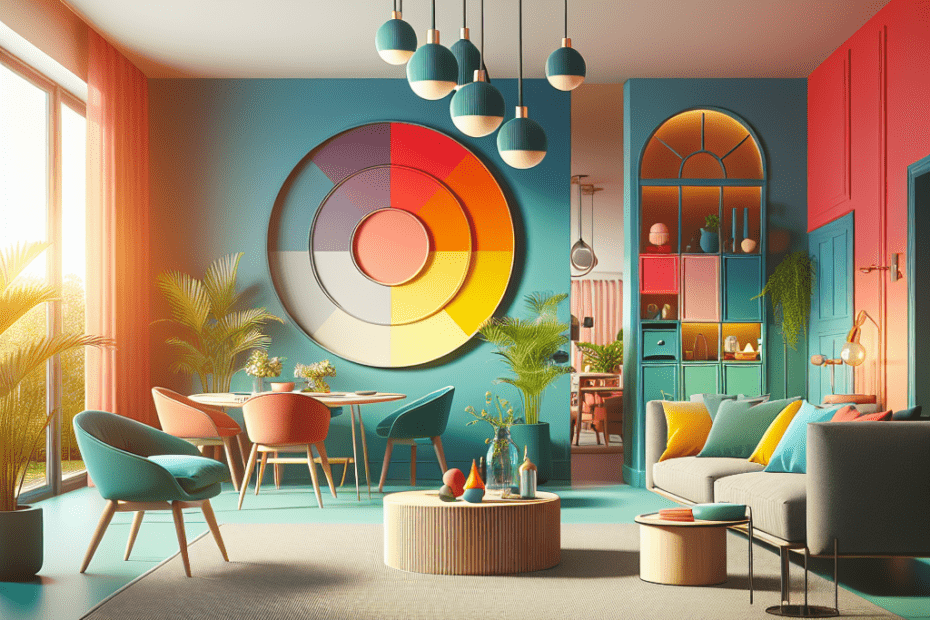Introduction
In the world of interior design, one of the most vibrant and effective methods to create harmony and balance in a room is through the use of triadic color schemes. Stylists who master this technique often find that it breathes new life into any space. Triadic color schemes, a celebrated method in the field of design, provide a clear guide for selecting hues that intrigue and harmonize. They draw from three equally spaced colors on the color wheel and have been proven to enrich spaces with both depth and excitement.
Understanding Triadic Color Schemes in Design
The triadic color scheme is based on colors that are evenly spaced on the color wheel. This means selecting three colors that are separated by 120 degrees, forming a perfect triangle. It’s an ideal recipe for a space that needs energy and balance. Designers often choose a dominant color and use the other two as accents, ensuring that one color doesn’t overpower the others. By applying this method, spaces can achieve a dynamic yet soothing visual appeal.
Examples of Triadic Color Schemes
A classic example of a triadic color scheme is the primary colors: red, blue, and yellow. When they are combined thoughtfully, they contribute to a balanced yet vibrant aesthetic. Another example is the use of secondary colors: green, orange, and purple, to create an inventive and lively environment. Designers should be mindful of saturation and the proportion of each color used to avoid overwhelming the space.
| Color Sets | Examples |
|---|---|
| Primary Colors | Red, Blue, Yellow |
| Secondary Colors | Green, Orange, Purple |
| Neutral-Inspired | Gray, Tan, Cream |
Implementing Triadic Color Schemes in Interior Design
Step-by-Step Guide
- Select Your Base Color: Begin with a dominant color for the room. This will be the foundation and the most used color.
- Choose Two Accent Colors: Pick the other two colors on the color wheel that complete the triad. These will add interest and should be used more sparingly.
- Balance the Space: Distribute these accent colors across various elements such as cushions, artwork, or curtains.
- Consider Neutral Elements: Use neutral tones to balance and ground the room. This prevents the colors from overpowering the senses.
- Experiment with Textures and Patterns: Incorporate different textures and patterns using the selected colors to add depth and enhance the design.
Advantages of Triadic Color Schemes in Design
Triadic color schemes offer several benefits:
- Visual Balance: This scheme provides a visual balance that is pleasing to the eye and creates a harmonious environment.
- Diverse Mood Settings: Depending on the hues chosen, a room can move from vibrant and energetic to calm and serene.
- Creative Expression: Encourages creativity as designers can experiment with various combinations while adhering to the triadic rule.
Statistics on Color Psychology
Research by Unsplash (2023) indicates that over 60% of people associate certain emotions with specific colors. The study highlighted that environments using well-coordinated color schemes often scored 70% higher in user satisfaction compared to those that did not.
Key Takeaways
- Triadic color schemes use three evenly spaced colors on the color wheel.
- They provide a dynamic yet harmonious look to any space.
- Primary and secondary colors are classic examples of this scheme.
- Effective balance is achieved by using one dominant and two accent colors.
- Adding neutral elements can ground the boldness of the scheme.
Frequently Asked Questions
-
What is a triadic color scheme?
A triadic color scheme uses three colors that are evenly spaced on the color wheel, offering visual contrast and harmony.
-
How does one select colors for a room?
Start with a dominant color and select two complementary accent colors to complete the triad.
-
Can triadic color schemes be used in small rooms?
Yes, though moderation is key. Using soft, lighter shades of the color palette can prevent the space from feeling overwhelming.
-
Are neutral colors considered in triadic schemes?
Neutrals can be used alongside the triadic scheme to balance and stabilize the look.
-
What are some common triadic color sets?
Common sets include red, blue, yellow and green, orange, purple.
